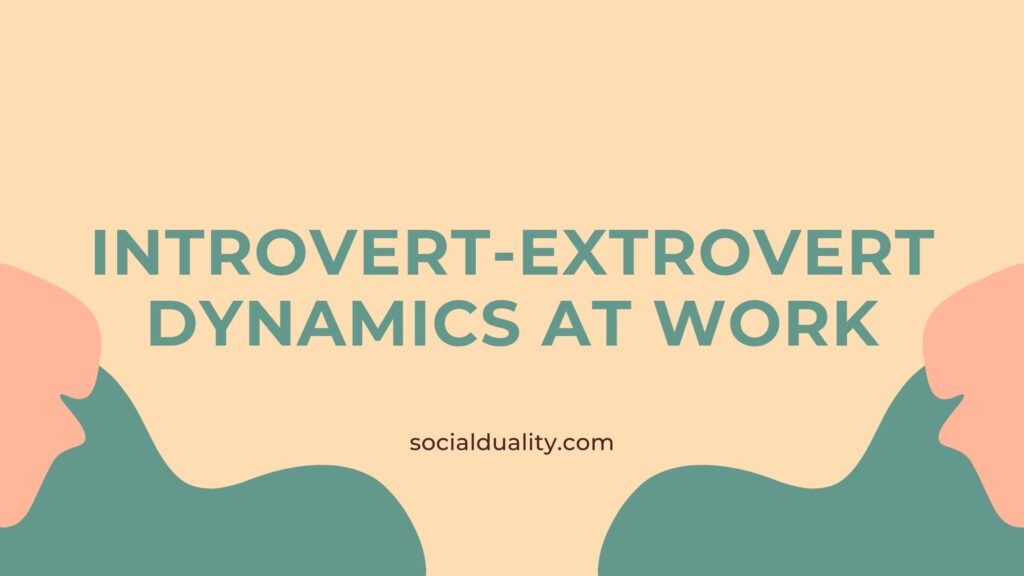Balancing introvert and extrovert dynamics at work can be tricky. While introverts may excel in solitary tasks, extroverts thrive on social interaction and collaboration. This blend creates a vibrant work environment, often leading to innovation and productivity.
Understanding these differences is crucial in fostering a harmonious work atmosphere. Introverts might feel overwhelmed during prolonged extrovert times, while extroverts could struggle with isolation. Recognizing and respecting these needs isn’t just a nicety—it’s essential for team cohesion.
The pandemic has also reshaped our social skills, pushing more people into remote work, impacting the introvert-extrovert relationship dynamic. Whether you’re an introvert, an extrovert, or an ambivert, knowing how to navigate these waters is key. Let’s explore how to make the most of these differences.
Key Takeaways
- Recognize and value the contrasting work styles of introverts and extroverts for a more productive environment.
- Introverts excel in solitary, focused tasks, while extroverts shine in social interaction and teamwork.
- The pandemic has altered social skills, impacting how introverts and extroverts feel in remote work settings.
- Ambiverts can bridge the gap, combining traits of both introverts and extroverts to create balance.
- Fostering a harmonious workplace requires understanding and respecting the different needs of all people.
Key Traits of Introverts and Extroverts
Introverts and extroverts bring unique qualities to the work environment. Introverts often prefer social interaction in smaller groups, finding solace in solitary tasks. They feel energized by quiet time. In contrast, an extrovert thrives on social engagement and gains energy from being around people. They excel in collaborative settings. Balancing these traits, an ambivert embodies the best of both worlds. Understanding these dynamics fosters a productive and harmonious work space. Each personality type offers distinct strengths, enriching the diverse work culture.
Uncover the Introvert’s World: Self-reliance and Introspection
Peering into the introvert’s world reveals a tapestry of self-reliance and deep thought. Instead of bustling around in a social frenzy, they often thrive in solitude, finding profound insights during their quiet moments. This introspection isn’t a hindrance but a strength, especially at work, where independent tasks shine. In contrast to an extrovert, an introvert can bring meticulous detail to projects, ultimately enriching the work environment. For more insights, the infographic on TheLazyLeader offers a more detailed perspective.
Discover the Extrovert’s Realm: Sociability and Assertiveness
Sociability and assertiveness dominate the extrovert’s domain. At work, they thrive in social settings, excelling in team projects and leading discussions. Their social skills foster connections, driving collaboration and innovation. People naturally gravitate towards their energy, making them effective in roles requiring constant interaction. Post-pandemic trends indicate that social interaction is crucial for mental well-being, as noted in Newsweek. Balancing this with the quieter strengths of an introvert creates a harmonious and productive environment for all.
The Introvert-Extrovert Spectrum: Ambiverts
Exploring the introvert-extrovert spectrum reveals fascinating insights about how ambiverts navigate their work environments. Ambiverts blend qualities of both introverts and extroverts, adapting their social interaction styles to various situations. This flexibility is invaluable in team settings, where they can balance people‘s needs and dynamics seamlessly. Research highlights their adeptness in social roles without feeling overwhelmed or drained, as seen in PubMed. This adaptability is key during post-pandemic times, ensuring productivity and harmony.
Ambiverts: The Best of Both Worlds
Balancing traits from both worlds, an ambivert navigates work effortlessly, thriving in varied environments. They adapt to different social interaction needs, excelling in both solitary tasks and team projects. This flexibility ensures they remain productive regardless of the setting. Post-pandemic, their ability to switch between introspective and expressive modes is invaluable. People often feel comfortable around them, benefiting from their balanced approach. Unlike strict introverts and extroverts, ambiverts resonate well across different work scenarios, fostering a harmonious and effective environment. This adaptability makes them indispensable assets.
Contrasting Work Styles: Introverts vs Extroverts
Contrasting work styles reveals how introverts and extroverts operate. An introvert thrives in quieter settings, finding energy in solitary tasks. Meanwhile, extroverts excel in bustling environments and enjoy team collaborations. This difference means introverts may lend meticulous attention to detail, while extroverts drive group dynamics. Balancing these traits, ambiverts effortlessly switch between solitude and social settings, making them versatile. Such diversity ensures that everyone has a role, creating a well-rounded workspace. Over time, blending these styles enriches the work environment for all.
5 Ways Introverts and Extroverts Approach Work Differently
When considering how introverts and extroverts approach their work tasks, differences become clear. Introverts typically prefer solitary tasks, diving deep into independent projects. They often need quiet time to recharge and focus. In contrast, extroverts thrive in team settings, drawing energy from interactions. They excel in brainstorming sessions and group discussions. Interestingly, ambiverts blend both styles, adapting to various work scenarios effortlessly. This balance ensures they meet diverse workplace demands, making them versatile and effective. Ambiverts’ adaptability often leaves people feeling comfortable and understood.
The Power of Introverts: Deep Thinking and Focus
The deep thinking and focus of quieter individuals often shine through in work environments. Their ability to dive into tasks without distraction allows for a level of concentration many find enviable. This dedication often leads to innovative solutions and creative insights. Unlike others who might get caught up in people dynamics, these individuals can maintain a steady course. For those interested in further exploring the benefits of this personality trait, Susan Cain’s book offers a compelling read.
The Strength of Extroverts: Teamwork and Enthusiasm
The enthusiasm and teamwork that extroverts bring to the table are truly unmatched. They thrive in group settings, infusing energy into every project. Extroverts excel by pulling people together, ensuring progress and unity. Utilizing their enthusiasm, they make team efforts engaging and productive. This lively approach creates a dynamic work atmosphere, driving innovation and efficiency. For a deeper understanding of how these dynamics play out in various settings, PubMed offers insightful research on this topic here.
Social Interactions in the Workplace: The Introvert-Extrovert Perspective
Examining work interactions from the introvert-extrovert perspective, an introvert feels more at ease in quiet settings, finding energy in solitude. On the flip side, extroverts thrive in vibrant team environments, drawing energy from interactions. This dynamic can create tension but also diversity. Striking a balance is where ambiverts shine, seamlessly blending both traits. They adapt effortlessly, making them invaluable in varied work scenarios. For a deeper dive into how these dynamics enhance workplace productivity, Susan Cain’s book offers compelling insights here.
How Introverts Navigate Social Interactions at Work
Navigating interactions within the work environment can be a challenge for those who prefer solitude. They often rely on structured meetings and clear agendas to manage these situations effectively. Finding pockets of quiet time during the day helps maintain focus and energy. They may also choose to communicate via email or messaging apps to avoid unnecessary face-to-face interactions. Over time, these strategies foster a more comfortable and productive work atmosphere, allowing them to thrive in their roles without feeling overwhelmed.
How Extroverts Energize Through Social Interactions at Work
Extroverts recharge through interactions at work by engaging in team activities and collaborative projects. These interactions create a lively environment where they draw energy and motivation. They often initiate conversations, brainstorming sessions, and social gatherings, fostering a sense of community and camaraderie. This dynamic approach not only boosts their own energy but also enhances overall team morale. Finding the right balance of interaction time helps them stay productive, maintaining their enthusiasm and drive throughout the day.
The Pandemic Effect: Shifting Introvert-Extrovert Dynamics
The pandemic has altered how we experience dynamics in the workplace. Many introverts find remote settings more conducive to productivity, appreciating the newfound quiet time. Meanwhile, those who thrive on vibrant team environments may struggle with isolation, seeking more interactive avenues. This shift requires a delicate balance of communication styles and work structures. For a deeper exploration of these changing dynamics, check out the insights on pandemic attendance impacts on social behaviors here. Balancing these needs can lead to a more harmonious and effective workspace.
Introvert Feels During Pandemic Times: Increased Comfort or Isolation?
Increased comfort or isolation during these times has had varying impacts on those who prefer quiet environments. Some find solace in remote work, appreciating the quiet time and increased control over their daily schedules. Others, however, feel more isolated, missing the in-person energy and connection. Balancing these preferences can be challenging but is crucial for maintaining productivity and mental health. Michael Hyatt delves into these nuances, offering strategies to overcome limiting beliefs in your professional life here.
Extrovert Times in a Pandemic: New Challenges or Opportunities?
Exploring new challenges or opportunities brought by the pandemic, work environments have evolved drastically. Remote settings offer quiet time, benefiting those who prefer solitude for productivity. However, those who thrive on team dynamics struggle with isolation. Balancing these shifts requires adapting communication styles and work structures. For some, it opens doors for flexibility and autonomy, while others miss the in-person energy. Striking a balance is key. For insights on managing these dynamics, check out Michael Hyatt’s strategies for overcoming professional challenges here.
Leveraging Introvert-Extrovert Dynamics for a Balanced Work Environment
Balancing dynamics between those who thrive on solitude and those energized by interaction is crucial for a productive work environment. By integrating structured meetings and quiet breaks, everyone’s needs are met. Embracing these differences fosters a harmonious workspace. For instance, those who enjoy team engagements can initiate brainstorming sessions, while others find solace in focused, quiet time. This synergy not only boosts overall morale but also enhances productivity. By valuing each individual’s preferences, a more inclusive and effective work culture is cultivated.
Creating Synergy: Uniting Introverts and Extroverts at Work
Uniting diverse personalities at work can truly create synergy. Workspaces thrive when both quiet thinkers and outgoing performers collaborate effectively. Finding harmony involves recognizing the strengths each brings. For example, introverted employees may excel in detailed tasks, while their counterparts might shine in brainstorming sessions. Including both structured meetings and quiet breaks ensures everyone’s needs are met. Michael Hyatt explores overcoming professional challenges stemming from such dynamics here. These strategies foster a balanced, productive environment where everyone flourishes.
Conclusion
Creating a balanced work environment means understanding and appreciating the strengths of both introverts and extroverts. By recognizing the unique qualities each brings, we can foster a more inclusive and productive workplace. Introverts offer deep thinking and focus, while extroverts bring energy and teamwork.
An ideal workplace encourages both types to thrive, creating synergy that benefits everyone. Let’s celebrate our differences and work together, blending our skills to achieve common goals. This harmony not only boosts morale but also drives success for the entire team.
FAQ
What are the key differences between introverts and extroverts at work?
Introverts often prefer solitude and deep thinking. They excel in tasks requiring focus and independence. Extroverts thrive in social environments. They are usually more assertive and energized by teamwork. While introverts might need quiet to recharge, extroverts gain energy from social interactions.
How do introverts and extroverts handle team projects differently?
Introverts tend to analyze and think deeply before contributing. They may prefer working alone on complex tasks. Extroverts, on the other hand, are more likely to lead discussions and bring enthusiasm to the group. They often excel in roles requiring quick decision-making and collaboration.
What makes ambiverts unique in the workplace?
Ambiverts blend traits from both introverts and extroverts. They can adapt to different situations, making them versatile team members. Ambiverts can work independently but also enjoy social interactions. This flexibility allows them to bridge communication gaps between introverts and extroverts.
How did the pandemic affect introvert-extrovert dynamics at work?
For introverts, remote work provided a comfortable environment to focus without the social pressures of an office. Some felt more productive and less stressed. Extroverts faced challenges with isolation. They missed the energy and interaction of a bustling workplace but found new opportunities through virtual meetings and online collaboration.
How can companies create a balanced work environment for both introverts and extroverts?
Companies can offer a mix of quiet spaces and collaborative areas. It’s important to recognize and value different work styles. Flexible work arrangements, like remote options and team-building activities, can help. Encouraging open communication ensures everyone’s needs are met, fostering a harmonious workplace.


